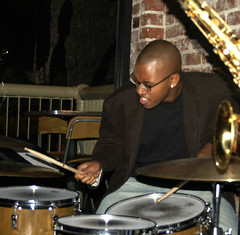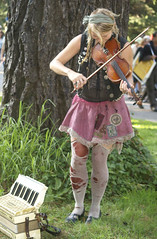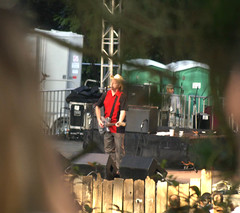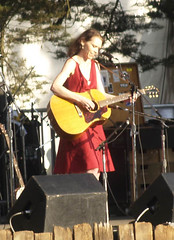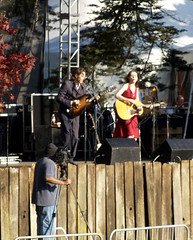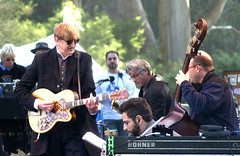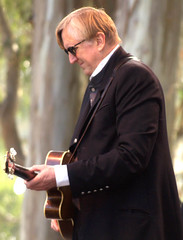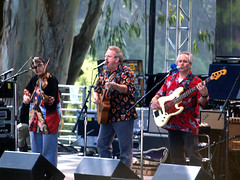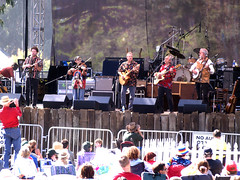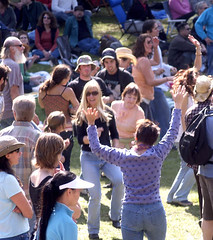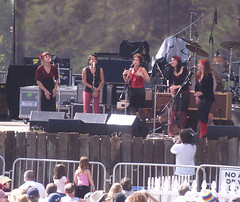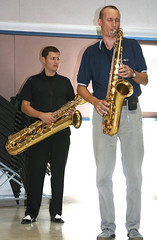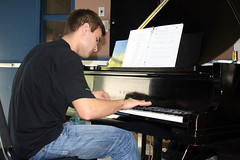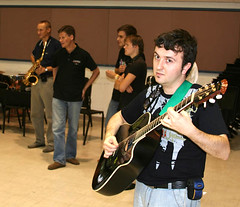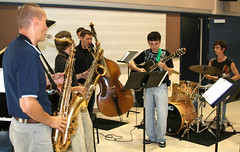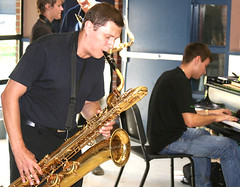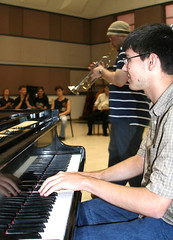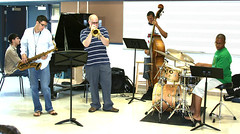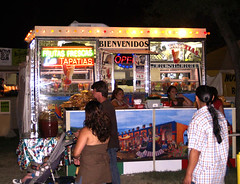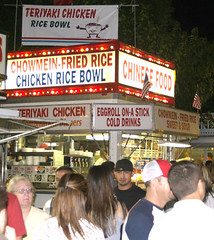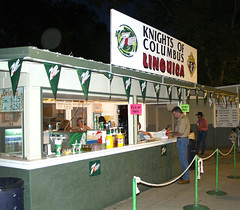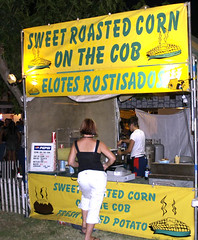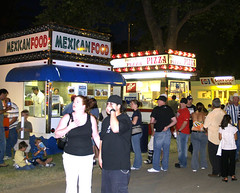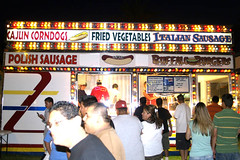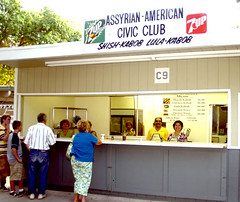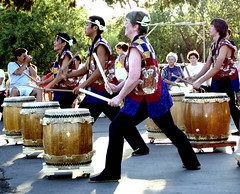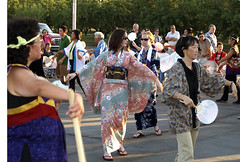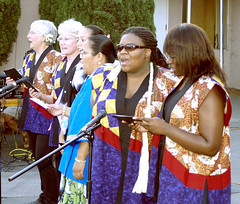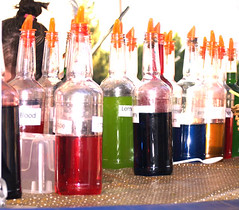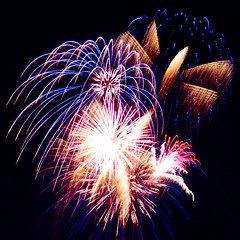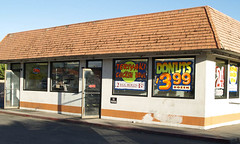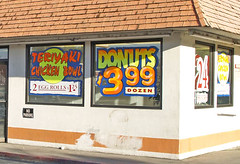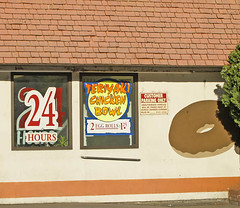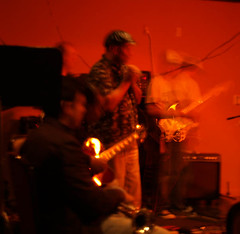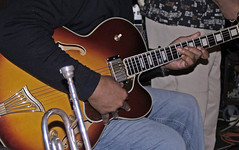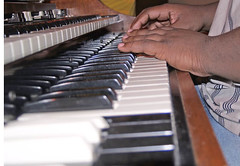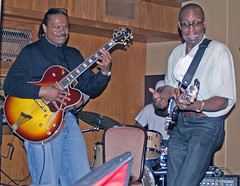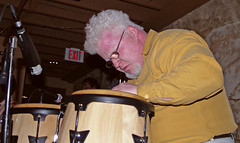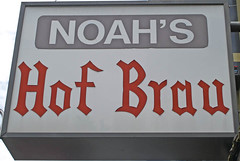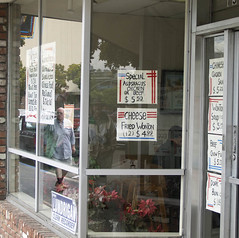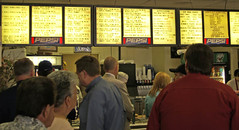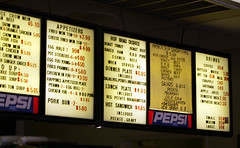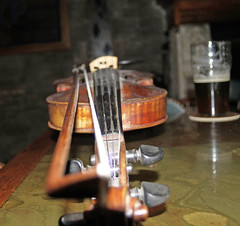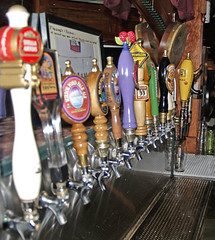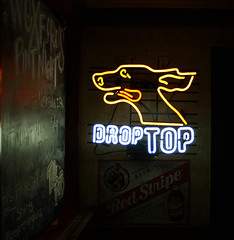Last night I accidentally discovered a whole new Teriyaki Donut called Gypsy Punk. It's a new musical movement out of the Russian area of New York that mixes Slavic styles of music with punk rock. The band that I hears play it is called Gogol Bordello. They opened for Primus in Berkeley.
Gogol Bordello is led by a tall, thin Romanian guy who wears green tights on stage and plays gypsy-style acoustic guitar. He's backed up by a full rock band, an accordion, a fiddle player and these two girls who occasionally run out on stage to sing back up while dressed in biker shorts and shirts and wearing skateboarding knee and elbow pad protection. They all dance a mix of the punk-style pogo stick and the line dancing that's often featured at Jewish weddings. Very strange to see.
The songs all have a heavy Slavic beat to it and use a mix of Romanian, Russian and English. The English is broken, as the lead singer has a very thick Romanian or Russian accent, but also sings with a Tom Waits-type grovel on top of it.
Lyrics include lines like "Upon arrivin' in the melting pot, I get penciled in as a goddamn white," "And you see brothers and sisters, all engaged in sport of help, making merry out of nothing like in a refugee camp," and "Start wearing purple for me now."
Oddly enough, the combination works really well. In some ways, they sound a bit like the early Pogues, which mixed Celtic and punk. They put on a heck of a show, although it's one of the strangest performances I have seen in a while.
Take the time to check them out. I purchased their album "Gypsy Punks Underdog World Strike," which I absolutely have no idea what it means. But my daughter and I listened to the album twice on the way home and they can add us as their newest fans.
Devoted to photos of teriyaki donut shops, taco trucks, great food, unusual or interesting foods, and any other commercial enterprise or cultural phenomenon that is just darned interesting to see.
Sunday, December 03, 2006
Sunday, November 12, 2006
Dave Brubeck Institute Quintet 3
Yup, I'm still alive. Just been really busy. Of course, I had to post this. Yet another jazz musician playing live in downtown Modesto. Besides the fact that Jazz is a mish-mash of musical styled from all around the world, it's also somewhat of a Teriyaki Donut that the Brubeck Jazz Institute Quintet (possibly one of the finest young quintets in the nation) would play in a country town like Modesto, California and draw a standing-room only crowd. Country meets jazz. Go figure.
Sunday, October 08, 2006
Bluegrass
I went to the Hardly Strictly Bluegrass Festival in San Francisco and captured some photos for this blog. So how does the American music of bluegrass fit in here?
Bluegrass is really the combination of three different types of music:
Irish music, blues and European folk. It came out of the Kentucky region originally, thus many people think that it's named after the famous grass from that area. But I recently had a music professor explain another theory - the name comes from the combination of Blues and grassroots or folk music.
Anyway, most of the bluegrass musicians I know also play Celtic and blues and most of the celtic musicians I know play blues and bluegrass as well. The styles really are similar.
Here is a punk rock girl playing bluegrass fiddle during the festival so she can earn some money.
One group I didn't get a photo of because it didn't occur to me until too late was The Pine Leaf Boys. They had a singer who played bluegrass but sang all his songs in traditional Creole - a mix of French, English and Spanish that's often only heard in Louisiana. That language alone is worthy of its own Teriyaki Donuts post.
Maybe another day, though.
Bluegrass is really the combination of three different types of music:
Irish music, blues and European folk. It came out of the Kentucky region originally, thus many people think that it's named after the famous grass from that area. But I recently had a music professor explain another theory - the name comes from the combination of Blues and grassroots or folk music.
Anyway, most of the bluegrass musicians I know also play Celtic and blues and most of the celtic musicians I know play blues and bluegrass as well. The styles really are similar.
Here is a punk rock girl playing bluegrass fiddle during the festival so she can earn some money.
One group I didn't get a photo of because it didn't occur to me until too late was The Pine Leaf Boys. They had a singer who played bluegrass but sang all his songs in traditional Creole - a mix of French, English and Spanish that's often only heard in Louisiana. That language alone is worthy of its own Teriyaki Donuts post.
Maybe another day, though.
Bluegrass punk
Famous British punk rocker Billy Bragg (started recording in the early '80s) performed a complete set of his folk songs at the festival. They fit right in since bluegrass draws heavily from folk. Bragg also threw in a country tune that he wrote as well as one from Johnny Cash.
Superstar
Gillian Welch performs her strict bluegrass set during the festival. She drew a huge overflow crowd. There must have been at least 10,000 people in her audience alone, even though there were five stages altogether.
Gillian Welch
Gillian Welch is a superstar in the bluegrass arena. She was promoted to that when one of her songs was picked for the soundtrack of "O Brother Where Art Thou?" She was then featured on the smach follow-up live album "Down From the Mountain." The crowd was so big for her, I couldn't get very close and had to use a zoom. Since light was quickly fading, it was difficult to get a good shot.
T Bone Burnett crossover
Here, Oscar-nominated and grammy-winning singer, songwriter and producer T Bone Burnett plays a nearly rock-like set while backed up by virtually all bluegrass musicians. Because bluegrass essentially came from a hodgepodge of other music from Ireland, Europe and Africa, it's easy to switch between styles because they all follow basically the same formulas.
T Bone Burnett
As I said earlier, many bluegrass musicians easily cross over between styles. Here, T Bone Burnett (Grammy winner and nominated for an Oscar) plays an all-electric set of his Tom Wait's like folk songs.
Austin Lounge Lizards up close
This is one of the big acts at this year's Mostly Strictly Bluegrass Festival, the Austin Lounge Lizards. They opened their set with a song called "Yet Another Stupid Song About Texas."
Austin Lounge Lizards
Like blues, bluegrass music sometimes can be irreverant. And one of the most irreverant groups out there is the Austin Lounge Lizards. Their latest album pokes fun at commercials, modern religion and the medical industry.
Dancers
As you can see, people of all ages still seem to enjoy Bluegrass. Here, they dance to a tune by The Stairwell Sisters.
The Stairwell Sisters
Here, The Stairwell Sisters perform a vocal-only or a cappella song during the festival. They were one of the few bands that stuck to almost all traditional bluegrass tunes.
Thursday, September 07, 2006
tenor sax
Jazz really has become a universal language. The Brubeck Institute at the University of the Pacific is hosting a visit by seven jazz players from Russia. The Russians will meet with Dave Brubeck and perform for him, perform at the Monterey Jazz Festival in two weeks, visit Yoshi's jazz club in Oakland and play a concert at the university.
They arrived Wednesday night and met with the members of the 2006 Brubeck Institute Jazz Quintet, five boys agest 18 - 19 who are studying the language of jazz.
While few of the Russians could speak English, the Brubeck Quintet and the Russians were able to speak through the language of jazz.
Both groups were impressive and will be playing in a concert at the University of the Pacific in Stockton on September 19, at 7:30 pm.
Pictured here, Dmitriy Kondrashov blows a solo while baritone saxophonist Yevgeniy Voloshin waits his turn. They were playing for American musicians in the rehearsal hall at the University of the Pacific.
They arrived Wednesday night and met with the members of the 2006 Brubeck Institute Jazz Quintet, five boys agest 18 - 19 who are studying the language of jazz.
While few of the Russians could speak English, the Brubeck Quintet and the Russians were able to speak through the language of jazz.
Both groups were impressive and will be playing in a concert at the University of the Pacific in Stockton on September 19, at 7:30 pm.
Pictured here, Dmitriy Kondrashov blows a solo while baritone saxophonist Yevgeniy Voloshin waits his turn. They were playing for American musicians in the rehearsal hall at the University of the Pacific.
Russian piano
Russian guitarist Petr Malanov warms up before performing for the American 2006 Brubeck Institute Jazz Quintet.
russian guitar
Russian guitarist Petr Malanov warms up before performing for the American 2006 Brubeck Institute Jazz Quintet.
Russian band
The Russian musicians play for the Americans at the University of the Pacific. They are: TAleksey Chernakov, piano; Artem Fedotov, drums; Dmitriy Kondrashov, tenor and soprano saxophones and flute and clarinet; Konstantin Safyanov, alto sax; Petr Malanov, guitar; Vadim Mikhaylov, bass; and Yevgeniy Voloshin, baritone saxophone.
bari sax
Russian altosaxophonist Dmitriy Kondrashov blows a saxophone solo in the rehearsal hall at the University of the Pacific.
American pianist
This is the 2006 Brubeck Institute Jazz Quintet: trumpeter Brian Chahley; saxophonist Lucas Pino; pianist Glenn Zaleski; drummer Cory Cox; and bassist Chris Smith. They were playing for a group of visiting Russian musicians in the rehearsal hall a the University of the Pacific. You can see the Russians sitting in chairs in the background. They were awed by the impressive talent of these young musicians.
American band
This is the 2006 Brubeck Institute Jazz Quintet: trumpeter Brian Chahley; saxophonist Lucas Pino; pianist Glenn Zaleski; drummer Cory Cox; and bassist Chris Smith. They were playing for a group of visiting Russian musicians in the rehearsal hall a the University of the Pacific.
Wednesday, August 30, 2006
Sunday, July 30, 2006
Greek Curly Nachos
This is just one of the many multi-cultural food booths found at the Stanislaus County Fair in Turlock, California. The fair food booths serve as a great example of how cultures have become mish-mashed in the United States. We adopt specific foods and flavors from other cultures and make them as American as possible. This booth served curly fries, nachos and Greek gyros all out of the same trailer.
Think about how bland America's culinary choices would be if we had stopped all immigration to the country 200 years ago.
Think about how bland America's culinary choices would be if we had stopped all immigration to the country 200 years ago.
Downtown Mexico?
This looks like a booth that would be found somewhere in Mexico. But it's one of the many multi-cultural food booths at the Stanislaus County Fair in Turlock, California.
No donuts?
What, no donuts? Actually, I took this at the Stanislaus County Fair in Turlock, California, because of the popular menu item - Eggroll on-a-stick. What says American fair food more than food on a stick? It's really a take-off of the corn dog which is a hot dog on a stick, except Chinese style.
Italian-American Linguica
I had a friend admit to me recently that he had never heard of Linguica until he moved to California. He even pronounced it LIN-GOO-KA for the longest time. It's properly pronounced LIN-GWEE-SA. It's a spicy Portuguese sausage that is often used in sandwiches, rice pilaf and on pizza in California. I took this photo at the Stanislaus County Fair because the organization serving the Portuguese delicacy is an Italian-American-Catholic organization known as the Knights of Columbus. Yet another great example of how one American group adopted something from another culture.
Sweet Elotes Rostisados
I tend to put too much butter on my Elotes Rostisados. Seriously. Regardless of what language it's in, corn on the cob says nothing but American cuisine to me. Who cares if it's advertised in English or Spanish?
Mexican pizza dogs
The Stanislaus County fair offered Mexican food, pizza and corn dogs, all within a stretch of a few yards.
Cajun Italian Sausages
County fairs often have a hodge podge of food. This booth could have been named "Foods of the World" and been its own exhibit. Cajun corndogs, asian-fried vegetables, Italian sausage, Polish sausage and Buffalo burgers. Wonder if they also served Pepto Bismo?
Persian-American food
Some areas of the country get unique food because of the immigrant groups that have settled there. In the Northern San Joaquin Valley in California, it's the Assyrian population, an ethnic group from Iran and Turkey. The area has the second largest Assyrian population in the United States, next to Chicago. But the area also has the largest Assyrian organization in the United States, the Assyrian-American Civic Club. Here's their food booth at the Stanislaus County Fair in Turlock, California. Great food, though oddly enough their shish kabobs aren't served on a stick, instead they are served on a roll smothered in tomatoes, peppers and lots of persian spices. Talk about a teriyaki donut of sorts.
Monday, July 17, 2006
Another short update ...
Here's a link to my story about the town of Cortez, as published in The Modesto Bee several years ago. My sincere thanks to editor Dan Day and online vice president Eric Johnston for making the story available online.
Though the story says it was updated today, it was actually published March 21, 1999. Eric and Dan posted it today as a favor to me so you could read the story.
I promise, I will move on from this subject. I have a Mexican-pizzaria and at least two more teriyaki donut joints in my sites.
Though the story says it was updated today, it was actually published March 21, 1999. Eric and Dan posted it today as a favor to me so you could read the story.
I promise, I will move on from this subject. I have a Mexican-pizzaria and at least two more teriyaki donut joints in my sites.
Friday, July 14, 2006
Sunday, July 09, 2006
Stockton Bukkyo Taiko Group
The Stockton Bukkyo Taiko Group performed over the weekend at the Cortez Obon Odori Buddhist Festival in Merced County, California. Though Taiko is strictly Japanese and Buddhism is firmly based in Asian culture, both have been widely adopted in the United States and made very American. The festival, though devoted to Japanese religion, served as a great example of how multiculture the United States is.
Small side story on Cortez - it was founded as a Japanese colony in the 1920s. But the folks adopted the name Cortez for their town because anti-Japanese sentiment was thick back then and they knew that many white-owned companies would not buy crops from the Yomato colony (the name of another Japanese town directly to the south). So they picked Cortez instead.
The town almost disappeared during World War II. Soldiers forced the townsfolks into a concentration, er, I mean internment, camp in Colorado. At the time, many banks would then call the loans of Japanese families once they learned that the family was in prison. That way, the banks could seize land that was nearly paid off and resell it again, thus destroying the Japanese families.
But in Cortez, something different happened. An attorney in the City of Merced (his name leaves me at the moment) sympathised with the Cortez families and was outraged at the actions of the government and the banks. So he visited the Cortez families in the camps in Colorado and became their attorney. He then leased their farms out to other area farmers and sued any banks that tried to seize their farms. Once the internment camps were dissolved, the Cortez families were able to return to their homes which had been maintained and paid for during their imprisonment. As a result, the area is still heavily influenced by the Japanese culture.
Small side story on Cortez - it was founded as a Japanese colony in the 1920s. But the folks adopted the name Cortez for their town because anti-Japanese sentiment was thick back then and they knew that many white-owned companies would not buy crops from the Yomato colony (the name of another Japanese town directly to the south). So they picked Cortez instead.
The town almost disappeared during World War II. Soldiers forced the townsfolks into a concentration, er, I mean internment, camp in Colorado. At the time, many banks would then call the loans of Japanese families once they learned that the family was in prison. That way, the banks could seize land that was nearly paid off and resell it again, thus destroying the Japanese families.
But in Cortez, something different happened. An attorney in the City of Merced (his name leaves me at the moment) sympathised with the Cortez families and was outraged at the actions of the government and the banks. So he visited the Cortez families in the camps in Colorado and became their attorney. He then leased their farms out to other area farmers and sued any banks that tried to seize their farms. Once the internment camps were dissolved, the Cortez families were able to return to their homes which had been maintained and paid for during their imprisonment. As a result, the area is still heavily influenced by the Japanese culture.
Japanese dancers
These are just some of the dancers who performed during the Cortez Obon Odori Buddhist Festival in Merced County, California over the weekend. The dancers came from a wide variety of backgrounds, from the blonde girl in the back to Japanese immigrants. I was surprised at how many non-Japanese people at the event were not only well-versed in Japanese culture, but had adopted parts of the Japanese culture as their own. It's yet another example of how other cultures have helped build the American tapestry.
But the cultural trade off apparently also works both ways. One of the dances and songs demonstrated at the festival was a "traditional" dance and tune about baseball.
But the cultural trade off apparently also works both ways. One of the dances and songs demonstrated at the festival was a "traditional" dance and tune about baseball.
Japanese Choir?
These are just some of the singers who performed during the Cortez Obon Odori Buddhist Festival in Merced County, California over the weekend. They are all singing in Japanese, yet I'm fairly certain that only one, maybe two, of the members is actually Japanese. Even though the event was held at a Japanese temple and every activity dealt with Japanese culture, it was incredibly multi-cultural. Once again, America has adopted parts of someone else's culture and made it its own.
Wednesday, July 05, 2006
The Fourth of July
The many syrups used to flavor ice at a "Hawaiian Ice Stand" set up at the 22nd annual Fourth of July celebration at the California State University, Stanislaus, in Turlock, California. I love the fact that it's called "Hawaiian ice" because flavored ice treats are most distinctly Italian. Nearby, people there were people eating tacos, burritos and drinking German beer. There also was a "Mongolian barbecue stand" on one side and a popcorn stand on the other (possibly the most American food I saw all day, since popcorn is believed to have been invented by the American natives). At night, everyone oooohed and aaaaaahed to fireworks and their distinctly Chinese origins. All in the name of celebrating the greatness of America. Chew on that for a while.
More on the Fourth
These are fireworks during the 22nd annual Fourth of July celebration at the California State University, Stanislaus, in Turlock, California. Only in America can we drink German beer, eat Mexican tacos and burritos, snack on Italian ice treats and watch Chinese explosives all to celebrate the United States of America.
Sunday, June 04, 2006
Scottys donuts sign
Here's the sign to Scotty's Donuts and Teriyaki Chicken, a restaurant that has the popular theme of selling donuts and teriyaki chicken bowls in the same location. You know, it's so you can get your donut with your teriyaki chicken. What, you don't do that?
This location was once a Burger King and then became a family-owned donut shop after an economic downturn and rise in crime in the area chased many of the chain businesses out of the area. Today, a homeless shelter is located directly behind the donut shop. The area is well-known for its drug and gang-related crime.
This location was once a Burger King and then became a family-owned donut shop after an economic downturn and rise in crime in the area chased many of the chain businesses out of the area. Today, a homeless shelter is located directly behind the donut shop. The area is well-known for its drug and gang-related crime.
Scottys donuts 1
This is an overall view of Scotty's Donuts and Teriyaki Chicken in Modesto, California. The building was first constructed in the late 1970s as a Burger King, a great location as it was near a New Deal Supermarket, down the street from a Jack In The Box and around the corner from Gallo Glass, one of the largest employers in the Northern San Joaquin Valley. But time has not been good to this area. The Burger King relocated to newer subdivisions about 15 years ago and this was turned into the family-owned donut shop known as Scotty's. Then the New Deal supermarket chain was pieced off to a bunch of independent owners, only to eventually close. The New Deal by Scotty's became a Save Mart, but even that closed for a better location. Instead, a homeless shelter opened behind Scotty's about 10 years ago. The area became known as "The Airport District" because of the proximity of the airport and became overrun with gangs. Scotty's was sold again and turned into Scotty's Donuts and Teriyaki Chicken Bowl. It has been like that for at least eight years now. Apparently, it's succesful since it seems to get a steady-stream of foot traffic from the homeless shelter and surrounding businesses.
Scottys donuts 2
Here's a look at the front of Scotty's Donuts and Teriyaki Chicken in Modesto. It once was a Burger King Restaurant, but an economic downturn in the area chased away most the chains. A homeless shelter located behind the donut shop also hasn't helped local businesses much. As you can see from advertisements in the windows, you can get a dozen donuts for $3.99 or two eggrolls for $1.25.
Scottys donuts 3
Here's a close up of the Scotty's Donuts and Terikyaki Chicken restaurant front windows. You can buy donuts, egg rolls or a Teriyaki Chicken bowl for a very low price. Notice the white splotches of paint on the front of the building. That's very common in this part of town as it's where the owners once again painted over gang graffiti. The graffiti will be back soon though, I'm sure of it.
Scottys donuts 4
The ads on the side of the restaurant. Notice that you can get donuts, eggrolls or teriyaki chicken bowls 24 hours a day, I guess so you can get a sugar rush when the methamphetamine finally wears out. The restaurant is located in a poorer area of town and has a homeless shelter located behind it. The Central Valley, where Modesto is in the heart of, is known as the methamphetamine capitol of the world. Modesto also is ranked as the car-theft capital of the United States. Most car thieves who are eventually caught admit that they stole the cars to sell parts so they could buy more methamphetamine, at least according to the local police department.
Wednesday, May 24, 2006
Jazz and Blues are one of the great culture clashes
Guitar player Carl Robinson jams on a traditional blues tune in the basement of Thymeless Restaurant during the Monday night blues jam in Downtown Modesto. This, and all the photos on this topic, were taken on May 22, 2006. This photo was taken with an open shutter to catch the colors and the motion, while still preserving the reflections off the instruments. Also, I think it accurately reflects the mood that night.
Jazz and blues are often referred to as the first original music form of North America, an argument I won't dispute. But it became possible because of the great American melting pot and the culture clash that it creates.
Jazz and blues are dominated mostly by European instruments, but rely heavily on African and Latin rhythms. The history of the music form can be traced to slaves in South, Central and North America who brought with them their traditional songs along with its traditional beats, and then blended that with Latin and European folk songs.
The music form later progressed into American bars and saloons where it was refined to what we know it as today.
Without the mix of cultures in the United States, Jazz and blues would have never been invented.
For more information, I suggest you visit this page.
Jazz and blues are often referred to as the first original music form of North America, an argument I won't dispute. But it became possible because of the great American melting pot and the culture clash that it creates.
Jazz and blues are dominated mostly by European instruments, but rely heavily on African and Latin rhythms. The history of the music form can be traced to slaves in South, Central and North America who brought with them their traditional songs along with its traditional beats, and then blended that with Latin and European folk songs.
The music form later progressed into American bars and saloons where it was refined to what we know it as today.
Without the mix of cultures in the United States, Jazz and blues would have never been invented.
For more information, I suggest you visit this page.
Robinson jams
Guitar player Carl Robinson jams on a traditional blues tune in the basement of Tymeless Restaurant during the Monday night blues jam in Downtown Modesto. The guitar, just like the piano, is distinctively European in origin. Few people realize this, but the guitar is traditionally tuned after the violin (they share the same tuning for the last four strings). A fiddle is traditionally tuned g-d-a-e. A guitar is tuned e-b-g-d-a-e.
Four of the strings share the same tuning, in the same order.
The Bass fiddle (stand-up bass to the rest of the world) also shares the same tuning as well (The last two strings on the guitar are tuned from the bass). A bass is tuned g-d-a-e, just like the last four strings on a guitar. Yet, the instrument is most often associated in the United States with blues and jazz music and its distinctive Latin and African rhythms.
Four of the strings share the same tuning, in the same order.
The Bass fiddle (stand-up bass to the rest of the world) also shares the same tuning as well (The last two strings on the guitar are tuned from the bass). A bass is tuned g-d-a-e, just like the last four strings on a guitar. Yet, the instrument is most often associated in the United States with blues and jazz music and its distinctive Latin and African rhythms.
Tuesday, May 23, 2006
Organ keys
A keyboard player plays a solo on "Brick House" in the basement of Tymeless Restaurant during the Monday night blues jam in Downtown Modesto. The keyboard is incredibly European in influence, having originated in Italy and spread throughout the European continent. Yet blues and jazz both have distinctive Latin and African rhythms.
Carl Robinson and bass player
Jazz guitarist Carl Robinson and a bass player jam on "Brick House" in the basement of Thymeless, a restaurant in downtown Modesto. Taken on May 22, 2006 during the Monday night blues jam session. They played a wide-variety of jazz and blues, which is basically a combination of African and South American folk music mixed in with European fols and classical music.
bongo player
This bongo player (sorry I don't know his name) played for several hours to both jazz and blues music at the Tymeless Restaurant in downtown Modesto. For me, this is yet another piece of evidence of how jazz and blues represent a fantastic clash of cultures. The bongos, you see, originated in Cuba around the 1800s, about the same time that slavery was abolished there. They are believed to have originated from a combination of African influence (specifically from Morroco) from the slave trade and the Abakua Religion in Cuba and South America. Yet, today, they are widely accepted as a jazz percusion instrument, which is considered to be very "North American."
Monday, May 22, 2006
Hof Brau sign
This is the sign to Noah's Hof Brau in downtown Modesto. Noah's Hof Brau used to be a German restaurant until it was purchased by a Chinese family about 20 years ago. They kept the name but radically changed the menu. The joke in Modesto is "Noah's Hof Brau has the best German food in the valley." I tried to get an overall shot of the front of the restaurant to show that it really does have a Hof-Brau feel to it (dark roof with wooden tiles) but a city tree is overgrowing in front of it, blocking most of the view.
Hof Brau windows
his is the window to Noah's Hof Brau in downtown Modesto. The Hof Brau used to be a German restaurant until it was purchased by a Chinese family about 20 years ago. They kept the name but radically changed the menu, as can be seen by the signs in the window. The papers signs seem to be propogating lately. They are all over the inside of the restaurant too, announcing menu items that the family doesn't have room to put on their light-up board.
Hof Brau menu3
This is the menu inside Noah's Hof Brau in downtown Modesto. The Hof Brau used to be a German restaurant until it was purchased by a Chinese family about 20 years ago. They kept the name but radically changed the menu. As you can see by the line, it's incredibly popular. There often is a line out the door and it's frequented by everyone from judges and attorneys to construction workers.
Hof Brau menu
This is the menu inside Noah's Hof Brau in downtown Modesto. The Hof Brau used to be a German restaurant until it was purchased by a Chinese family about 20 years ago. They kept the name but radically changed the menu. The prices aren't too bad, though just about everything is soaked in gravy or msg. Oddly enough, there are some food items that are not on the menu. One popular dish is the 1 1/2 which is a combination of the number one and number two - giving you pork, rice and chow mein.
Hof Brau menu2
This is the menu inside Noah's Hof Brau in downtown Modesto. Noah's Hof Brau used to be a German restaurant until it was purchased by a Chinese family about 20 years ago. They kept the name but radically changed the menu. As you can see, there are some sandwiches, but most people go for the Chinese food.
Thursday, May 04, 2006
fiddle
This is a fiddle used by Steve Kenworthy, a talented fiddle player who plays often at P. Wexford's in Modesto. He mostly plays Celtic music at the pub, but also plays blues, jazz and the occasional classical song. Notice the Guiness sitting next to it. P. Wexford's is an Irish-themed Pub in Modesto California that serves imported and domestic beers along-side hamburgers and nachos. Though it features Celtic music at least once a week, it's mostly dominated by modern rock and frequented by 20-somethings. It does serve as a shining example of how the Irish culture has been adopted in America. For more photos, see my Flicker site.
spouts
These are the beer spouts in P. Wexfords of Modesto, an Irish pub that's really more American than Irish.
droptop
This is the Drop Top neon sign inside P.Wexford's Pub in Modesto California. The pub is a shining example of how the Irish culture has been adopted in America. The pub features Celtic music one night a week and lots of posters about Ireland, but also serves hamburgers and nachos. Rock bands usually play the other nights.
Subscribe to:
Posts (Atom)
